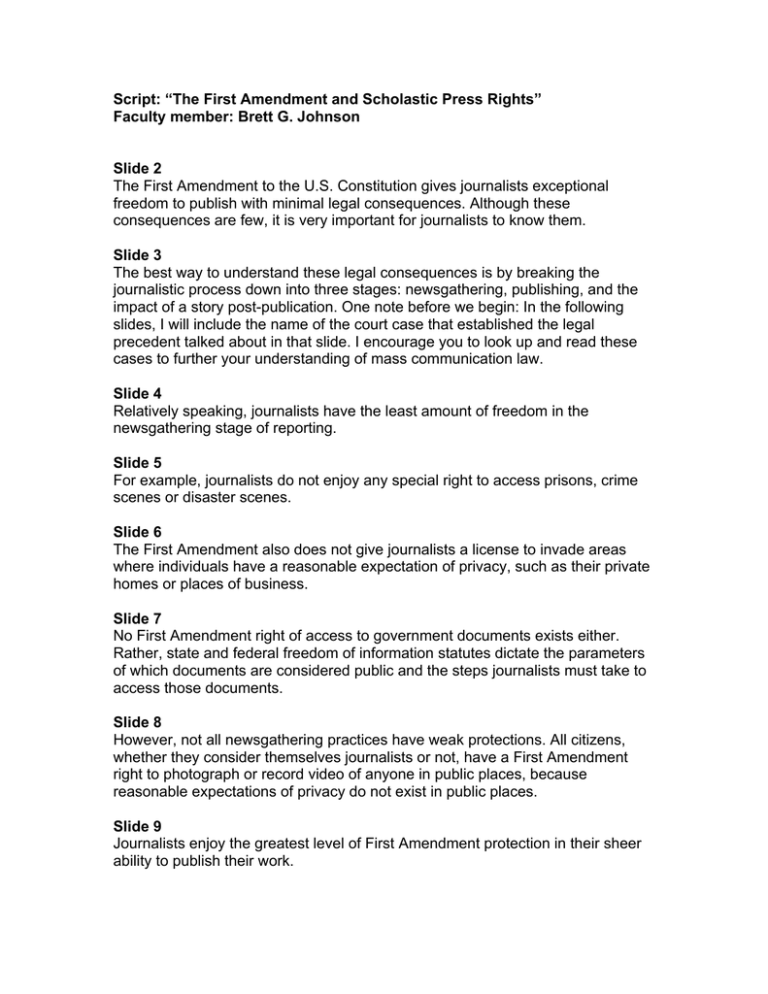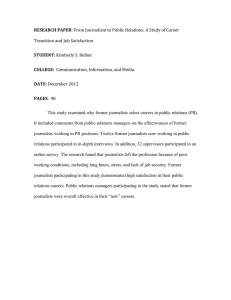Script: “The First Amendment and Scholastic Press Rights” Faculty
advertisement

Script: “The First Amendment and Scholastic Press Rights” Faculty member: Brett G. Johnson Slide 2 The First Amendment to the U.S. Constitution gives journalists exceptional freedom to publish with minimal legal consequences. Although these consequences are few, it is very important for journalists to know them. Slide 3 The best way to understand these legal consequences is by breaking the journalistic process down into three stages: newsgathering, publishing, and the impact of a story post-publication. One note before we begin: In the following slides, I will include the name of the court case that established the legal precedent talked about in that slide. I encourage you to look up and read these cases to further your understanding of mass communication law. Slide 4 Relatively speaking, journalists have the least amount of freedom in the newsgathering stage of reporting. Slide 5 For example, journalists do not enjoy any special right to access prisons, crime scenes or disaster scenes. Slide 6 The First Amendment also does not give journalists a license to invade areas where individuals have a reasonable expectation of privacy, such as their private homes or places of business. Slide 7 No First Amendment right of access to government documents exists either. Rather, state and federal freedom of information statutes dictate the parameters of which documents are considered public and the steps journalists must take to access those documents. Slide 8 However, not all newsgathering practices have weak protections. All citizens, whether they consider themselves journalists or not, have a First Amendment right to photograph or record video of anyone in public places, because reasonable expectations of privacy do not exist in public places. Slide 9 Journalists enjoy the greatest level of First Amendment protection in their sheer ability to publish their work. Slide 10 The U.S. Supreme Court has held that the act of government restraining publication – or prior restraint – is presumed unconstitutional. Slide 11 Such “prior restraints” are allowed only when the government can prove that the publication will cause certain, immediate and irreparable harm to life or property, which is a very difficult task. Slide 12 In very rare circumstances, trial court judges can restrict the press from publishing information that may be prejudicial to a criminal defendant’s right to a fair trial. Slide 13 Also, violations of copyright law can lead to restraints put on publication. Slide 14 The First Amendment gives journalists a high level of protection from lawsuits and criminal sanctions that their publications may trigger. Slide 15 For example, public officials and public figures can only recover for defamation if they can prove that journalists published false information about them with reckless disregard for whether that information was true or false. Slide 16 Also, plaintiffs can only recover for publication of private facts if they can prove that the facts are not a matter of public concern and their publication is highly offensive to a reasonable person. Slide 17 However, the publication of obscenity—defined as sexual or scatological images that appeal to prurient interests and have no legitimate artistic, educational or political value—is not protected and can lead to criminal charges against the publisher. Slide18 Generally speaking, as long as journalists legally obtain truthful information, they are free to publish that information without fear of criminal or civil repercussions. Such information includes names of juveniles. Some states have statutes that make it easier for juveniles to recover for publication of private facts about them, and journalists should be aware of these. But, once again, if journalists publish truthful information that they have obtained legally, they should be safe from legal problems. Slide 19 All of the preceding legal guidelines apply to student journalists as minimum standards. However, student journalists at public high schools receive less First Amendment protection that adult journalists. Slide 20 In the 1988 case Hazelwood School District v. Kuhlmeier, the U.S. Supreme Court held that educators and administrations at public high schools could exercise editorial control of student press, as long as their actions are “reasonably related to legitimate pedagogical concerns.” This holding has given educators and (especially) administrators great censorial power over the content of their students’ journalistic works. Slide 21 Ten states have passed laws granting students in public high schools greater protection from administrative censorship than what is currently allowed under Hazelwood. These states are: Arkansas, California, Colorado, Iowa, Kansas, Massachusetts, North Dakota, Oregon, Pennsylvania, and Washington. The language of these statutes varies, but they may entitle student journalists to injunctive relief from censorial efforts by administrators. If you live in a state that has such a statute, be sure to know the extent of the rights that it grants you.


